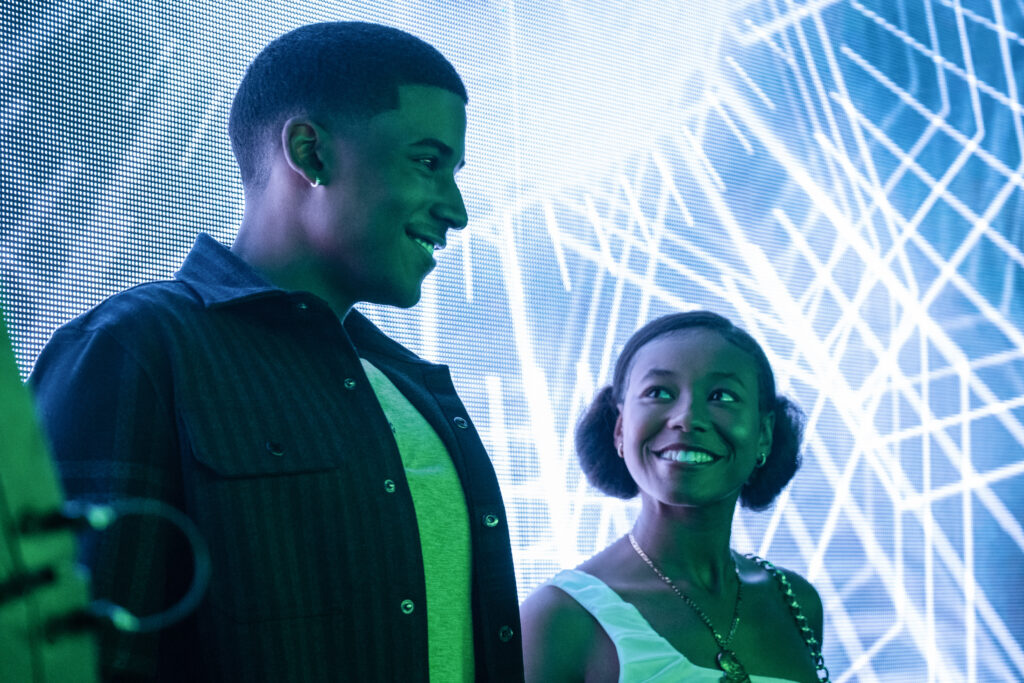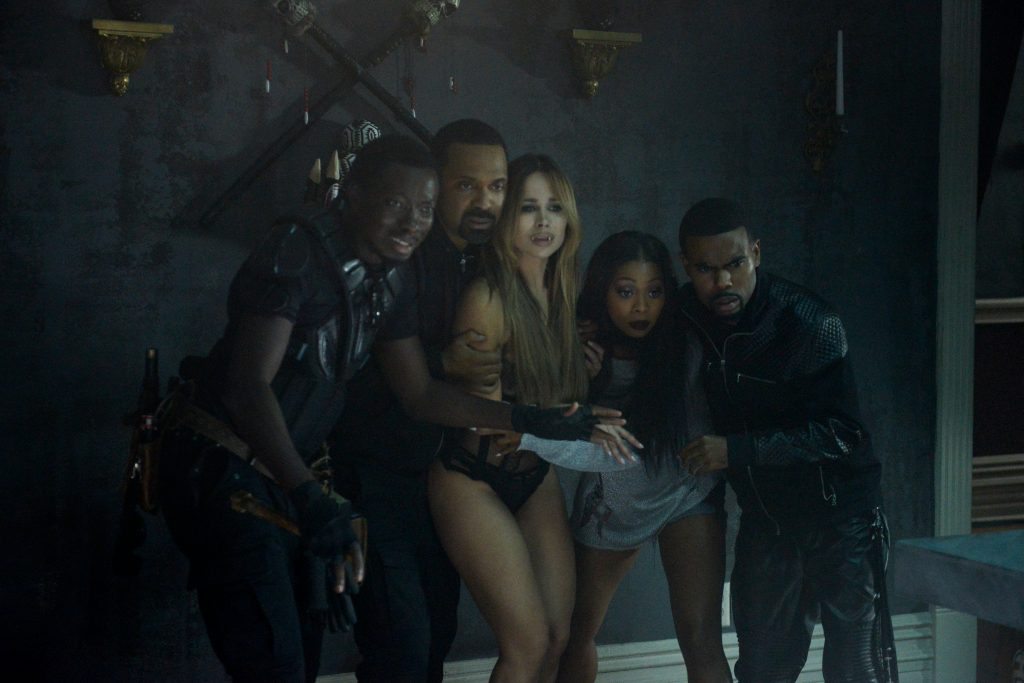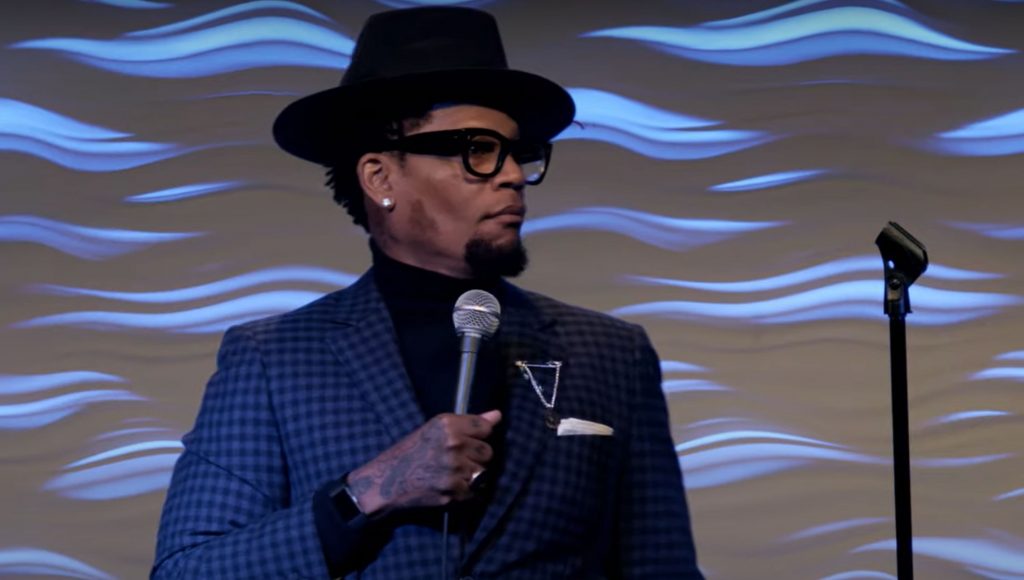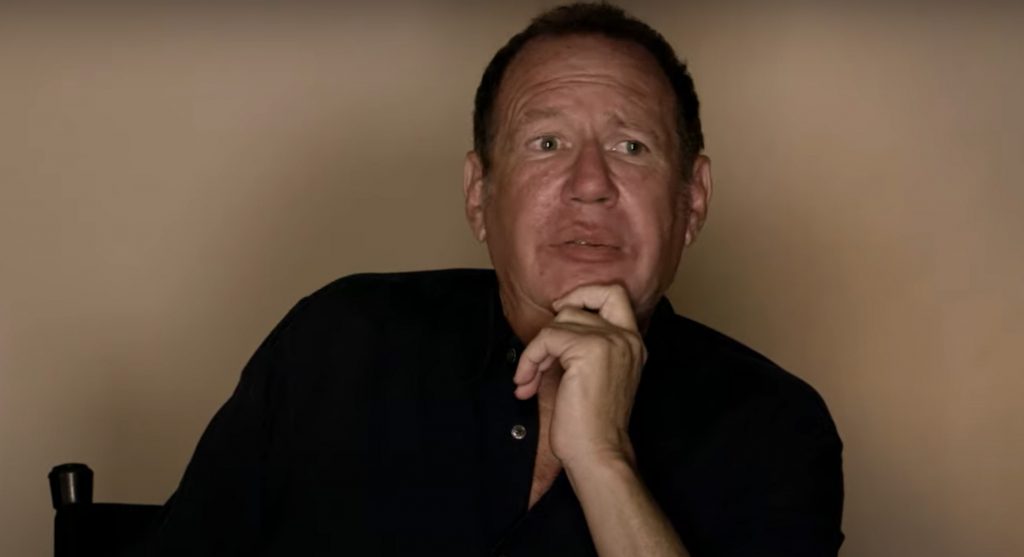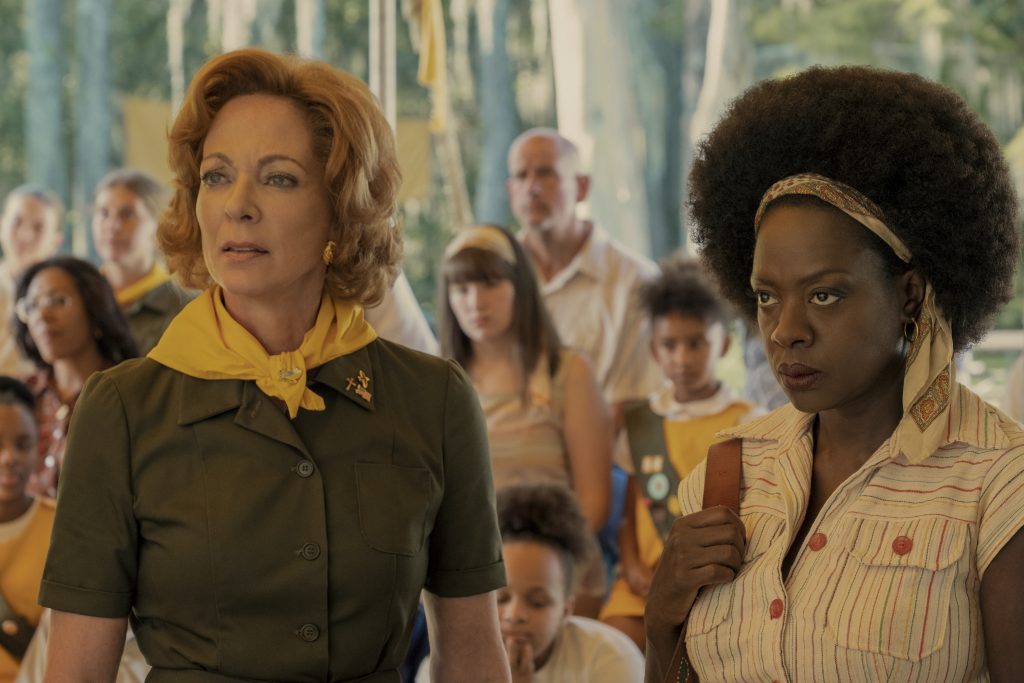February 13, 2024
by Carla Hay

Directed by SJ Clarkson
Culture Representation: Taking place in 2003 (with brief flashbacks to 1973), in New York City and in the Amazon jungle of Peru, the superhero action film “Madame Web” (based on Marvel Comics characters) features a predominantly white cast of characters (with some African Americans, Latinos and Asians) portraying superheroes and regular human beings.
Culture Clash: A fire-department paramedic, who grew up as an orphan, finds out that she has spider-related psychic abilities that came from her mother’s mysterious death, and she helps protect three teenage girls who are being hunted by the man who killed her mother.
Culture Audience: “Madame Web” will appeal primarily to people who are fans of star Dakota Johnson and movies based on Marvel Comics, but the movie is an idiotic mess, by any standard of bad superhero movies.

“Madame Web” and “The Marvels” are the “Dumb and Dumber” of female-led Marvel Comics superhero movies. After the triumphs of “Black Widow” and “Black Panther: Wakanda Forever,” it’s a travesty that “Madame Web” is a low point in wannabe feminist superhero films. Perhaps the only good thing to come out of “Madame Web” is that it is an unintentional comedy, because there is so much idiotic filmmaking on display, it’s laughable. Other people who won’t find it so funny will be cringing at “Madame Web,” which is an embarrassment for everyone involved in making this brain-dead film.
Directed by SJ Clarkson, “Madame Web” was co-written by Clarkson, Matt Sazama, Burk Sharpless and Claire Parker. “Madame Web” will get inevitable comparisons to 2023’s “The Marvels” because these two flops are obvious attempts to build a franchise around two separate groups of female superheroes. (See 2021’s “Black Widow” and 2022’s “Black Panther Wakanda Forever” for Marvel Comics-based, female-led superhero movies that are done right.) Whereas the story in “The Marvels” was overly ambitious and got tangled up in doing too many things in too many places, “Madame Web” tries to keep the story simple, but in doing so just exposes even more rapidly that it’s a mind-numbing, stupid mess.
“Madame Web” begins in 1973, in the Amazon jungles of Peru. An American scientist named Constance Webb (played by Kerry Bishé) is looking for a rare spider that has the potential to cure hundreds of diseases. Accompanying her on this expedition is an American named Ezekiel Sims (played by Tahar Rahim), whom Constance has hired to be her guide. Constance also happens to be about eight or nine months pregnant.
Ezekiel is over-eager for Constance to find this spider. His impatience should’ve been a big red flag to Constance that Ezekiel has ulterior motives. However, Constance is too preoccupied with finding this spider to notice. When she does find the spider, Ezekiel shoots her, steals the spider, and runs away.
Constance doesn’t die immedately. She is unconscious when she is saved by two tree-crawling and tree-hopping “spider men” of Peru (who basically look like acrobats with painted red skin), who bring her to a swampy area, put a spider on her chest, and deliver Constance’s baby, which is a girl. The spider on Constance’s chest was no ordinary spider. It bit Constance before the baby was delivered, so whatever type of venom the spider had has now been transferred into the blood of the baby.
Constance doesn’t survive, but her baby does, and the baby does not cry at all after being born. One of the Peruvian jungle dwellers who delivered the baby is named Santiago (played by José María Yazpik), who states solemnly to this newborn that she will eventually come back to this jungle to find him for answers to her questions. And when she does, Santiago adds, “I will be here for her.”
The movie then fast-forwards to 2003 in New York City. Constance’s baby is now a jaded 30-year-old bachelorette named Cassandra “Cassie” Webb (played by Dakota Johnson), who works as a paramedic for the Fire Department of New York. It’s mentioned in the movie that Cassie grew up as an orphan in the foster care system. Her biological father is never mentioned in the movie.
Cassie’s best friend is her paramedic co-worker Ben Parker (played by Adam Scott), who is also never-married with no children. Cassie and Ben, as they announce during their dull dialogue, don’t like the idea of “the family thing,” although Ben has been recently dating a special woman, and the relationship is getting serious. Ben won’t share any details about this relationship with Cassie, probably because he knows that bitter spinster Cassie will be jealous.
How do we know that Cassie is bitter about family love? When she saves a woman from a car accident and is at the hospital, the woman’s son (who’s about 8 or 9 years old) gives her a drawing that he made as a gift for saving his mother’s life. Cassie coldly asks Ben what she’s supposed to do with this gift since she doesn’t want it. Ben tells her she should just throw it in the garbage when the kid isn’t there.
It isn’t long before Cassie finds out that she has psychic abilities where she can see events that happen in the future. She discovers this clairvoyance after falling into the Atlantic Ocean while rescuing a man trapped in a car near a bridge. Ben rescues Cassie in a very sloppily staged scene, which is when she first finds out that she can see into the future.
Mike Epps has a very small and brief role as a paramedic supervisor named O’Neil, whose fate does not come as a surprise, since his character wasn’t useful to the overall story. Emma Roberts has a supporting role as Mary Parker, the pregnant wife of Ben’s brother Richard, who is never seen in the movie because he’s away working in Mumbai. Mary is eight months pregnant, and her pregnancy is used for exactly what you think it will be used for in a “race against” time scene later in the movie.
Meanwhile, Ezekiel (who is some type of scientist) was bitten by the spider that he stole, so now he has the ability to poison people just by touching them and holding them long enough. (Don’t ask.) After meeting an opera concertgoer whom he took home for a one-night stand, Ezekiel wakes up from a cold-sweat nightmare and tells her that he keeps dreaming of three teenage girls who want to kill him. His nightmarish visions show that all three girls are dressed as spider superheroes.
Ezekiel enlists the help of a technology expert named Amaria (played by Zosia Mamet) to find these three teenagers, because (as Ezekiel hilariously announces repeatedly in the movie), he wants to kill them before they can kill him. Amaria is only seen working for Ezekiel in a room with hi-tech equipment, such as surveillance cameras that are apparently everywhere in the New York City area.
“Their faces have been taunting me for years,” Ezekiel comments to Amaria about these teen tormenters. “Find them, and I’ll pay you a fortune.” Ezekiel tells Amaria several times that he will kill her if she doesn’t do what he wants. It’s later mentioned in the movie that Ezekiel thinks he’s going to be killed because he was cursed for stealing the spider.
The identities of the three teenagers are Julia Cornwall (played by Sydney Sweeney), a nervous people-pleaser; Mattie Franklin (played by Celeste O’Connor), a rebellious rich kid; and Anya Corazon (played by Isabela Merced), a level-headed undocumented immigrant. All three have encountered Cassie before they formally meet. Julia’s stepmother was a patient rescued earlier in the movie by Cassie, and Julia saw Cassie at the hospital. While skateboarding on a busy street, Mattie was nearly hit by a paramedic ambulance that Cassie had been driving on the way to the accident. Anya lives in the same apartment building as Cassie.
The rest of “Madame Web” is one ridiculous scenario after another where Casse tries to save Julia, Mattie and Anya from being murdered by Ezekiel, because Cassie had a psychic vision that it would happen when all them are on the same train. By rescuing these three teens and putting them in the woods to hide them, Cassie becomes a kidnapping suspect. Cassie spends much of the movie acting like a stern boarding school headmistress to these confused and bickering teenagers.
The acting in “Madame Webb” ranges from mediocre to bad, with Rahim’s stiff performance being the worst. Rahim’s wooden acting and questionable American accent (he’s French in real life) further sink the quality of this already low-quality superhero movie. The action sequences are flashy but empty. And don’t bother sticking around for a mid-credits or end-credits scene, because there is none.
The movie’s soundtrack choices sound like the filmmakers were thinking, “What songs would feminists and teenage girls be listening to in 2003?” The answer, according to “Madame Web”: Meredith Brooks’ “Bitch” and Britney Spears’ “Toxic.” The movie’s very “on the nose” soundtrack is in stark contrast to the rest of “Madame Webb,” which misses the mark in almost every single way.
Columbia Pictures will release “Madame Web” in U.S. cinemas on February14, 2024.


